“Cultural heritage faces more significant threats right now than ever before, from economic development to climate change. But the most serious threat to heritage comes from autocratic governments ready to reshape the past into a fiction that legitimates their domination.”
Adam T. Smith, Distinguished Professor of Arts and Sciences in Anthropology, Caucasus Heritage Watch (CHW) 2022
“Azerbaijan has been destroying sites clandestinely. It’s a state secret. So unlike ISIS, or the Taliban, which made a big spectacle out of their form of heritage destruction, Azerbaijan does not want to be known as a state that sponsors cultural erasure. They spent a lot of money on UNESCO trying to brand Azerbaijan as a land of tolerance even as they undertook a systematic program of heritage demolition.”
Lori Khatchadourian, Cornell University, Caucasus Heritage Watch (CHW) 2022
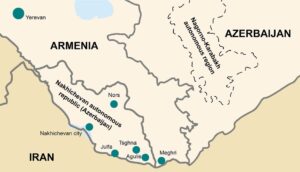
Map of Nakhichevan on left, autonomous republic (Azerbaijan) with Soviet Administrative borders. Nagrono Karabakh on right.
The deliberate destruction of Armenian monuments is key to Azerbaijan’s claims to historical ownership of the disputed territories of Nakhchivan and Nagorno-Karabakh. By bulldozing historic sites and virtually erasing Armenian history in these regions, Azerbaijan’s Aliev regime has weaponized cultural heritage. The regime believes that without historic evidence of the Armenian people in these regions, Armenians will have no claim to the land.
Researchers have documented almost unbelievable losses in Nakhchivan dating from the 1990s through the 2000s, during the rise of the Aliev regime under the father of the current President. (See Argam Ayvazyan: Spy–Researcher For Nakhichevan Armenian Culture, a fascinating interview by Andran Abramian, Cultural Property News, March 27, 2021)
Long-running tensions between Armenia and Azerbaijan over the disputed territories rose to a serious conflict in the 1990s, then simmered into periodic ceasefire violations for two more than two decades after 1994.

Location of St. Thomas church in Agulis indicated by a cross on a Soviet military map and a satellite image showing the new mosque built in its place. Courtesy Argam Ayvazyan.
Throughout this time, there was incremental damage and then demolition of Armenian sites in the Nakhchivan Autonomous Republic. Almost every Armenian historical building, church or cemetery in the over 2000 square mile enclave was destroyed.
The destruction in Nakhchivan has been confirmed through a major study by Caucasus Heritage Watch just published in September 2022; the same research group is also documenting instances of damage starting to take place in Nagorno Karabakh after the 2020 Nagorno-Karabakh War, when significant formerly Armenian-occupied territory came under Azerbaijani control. While there were certainly reciprocal incidents of deliberate Armenian destruction of Azeri homes and mosques during the war, the vast scale and deliberate nature of the elimination of Armenian heritage by Azerbaijani officials makes clear that it is not an accident of war but a state-sponsored attempt to eliminate a people’s history.
International condemnation of Azerbaijan’s heritage destruction

Medieval period Surb Karapet (Holy Precursor Church) in Abrakunis, © Argam Ayvazyan archives, photo 1970-1981
Azerbaijan’s autocratic President Aliev is leading the campaign to deny historic reality and eliminate all records of Armenians in Azerbaijan. Aliev has territorial aims in his subversion of history and is using cultural destruction to secure Azerbaijan’s hold on both Nakhchivan and Nagorno-Karabakh. Eliminating the historical record to effect political goals is nothing new. President Xi has done the same by bulldozing mosques and cemeteries, destroying the evidence of minority Muslim culture in Xinjiang, China, and Putin is now using similar tactics of cultural denialism to justify the seizure of Ukrainian territory by Russia.
President Aliev has ignored the alarms raised in Europe and the U.S. On 10 March 2022, the European Parliament agreed to a Resolution on the destruction of cultural heritage in Nagorno-Karabakh, noting that 1,456 monuments, mostly Armenian, came under Azerbaijan’s control after the ceasefire of 9 November 2020, that many had suffered deliberate damage and that Azerbaijan’s President Aliev had vowed to remove Armenian inscriptions from cathedrals and churches. The Parliament also noted:
“the irreversible destruction of religious and cultural heritage has been carried out by Azerbaijan, notably in Nakhchivan Autonomous Republic, where 89 Armenian churches, 20 000 graves and more than 5 000 headstones have been destroyed…”
The Resolution stated: “the elimination of the traces of Armenian cultural heritage in the Nagorno-Karabakh region is being achieved not only by damaging and destroying it, but also through the falsification of history and attempts to present it as so-called Caucasian Albanian… on 3 February 2022,
the Minister of Culture of Azerbaijan, Anar Karimov, announced the establishment of a working group responsible for removing ‘the fictitious traces written by Armenians on Albanian religious temples.’”
And, “that the erasure of the Armenian cultural heritage is part of a wider pattern of a systematic, state-level policy of Armenophobia, historical revisionism and hatred towards Armenians…, including dehumanisation,
A mosque buit in 2013 on the bulldozed site of medieval Surb Karapet in Abrakunis (courtesy Djulfa.com)
the glorification of violence and territorial claims against the Republic of Armenia which threaten peace and security in the South Caucasus…”
The European Parliament called on Azerbaijan: “to fully implement the provisional decision of the [International Court of Justice], in particular by ‘refraining from suppressing the Armenian language, destroying Armenian cultural heritage or otherwise eliminating the existence of the historical Armenian cultural presence or inhibiting Armenians’ access and enjoyment thereof’ and by ‘restoring or returning any Armenian cultural and religious buildings and sites, artefacts or objects.”
The International Court of Justice December 7, 2021 decision cited by the European Parliament linked cultural destruction with racial discrimination under the 1965 International Convention on the Elimination of All Forms of Racial Discrimination.
Caucasus Heritage Watch documents “a systematic, state-sponsored program of cultural erasure”

Argam Ayvazyan next to a 14th-century khachkar in Nors (today Nursu) (© Argam Ayvazyan archives, 1970-1981, (courtesy Djulfa.com)
Caucasus Heritage Watch is an independent research project located at Cornell and Purdue Universities. It is led by four archaeologists who have monitored the deliberate destruction of monuments now under Azerbaijan’s jurisdiction. Their work utilizes historical sources, the on-site researches of cultural historian Argam Ayvazyan between 1954 and 1967 in Nakhichevan, and a thorough analysis of satellite imagery.
Research by Caucasus Heritage Watch (CHW) shows that Azerbaijan has not in any way halted its destruction of Armenian monuments or its program of falsification of history. CHW issued a Nagorno-Karabakh Monitoring Report #3 in December 2021. CHW notes that since the report was issued, additional cemeteries have disappeared and that “destruction of St. Sargis church in the village of Mokhrenes in Karabakh between March and July 2022 provides evidence of the first major violation of a ruling by the International Court of Justice, which ordered Azerbaijan in December 2021 to prevent such acts.”
CHW states in another report that:
“There is reason to fear that the template for cultural erasure in Nakhchivan will be pursued in the Nagorno-Karabakh region, too. CHW has already documented the beginnings of a similar pattern, with 6 [cultural heritage sites] confirmed destroyed, 7 confirmed damaged, and 17 threatened since the Nagorno-Karabakh War began in September 2020.”
Khatchadourian, Smith, Ghulyan, & Lindsay, Silent Erasure: A Satellite Investigation of the Destruction of Armenian Cultural Heritage in Nakhchivan, Azerbaijan, Caucasus Heritage Watch, September 2022, pg 6.
Silent Erasure is a detailed, 269 page study on the elimination of monuments in the Nakhchivan Autonomous Republic, a landlocked exclave of the Republic of Azerbaijan.

Some of Djulfa’s thousands of khachkars before their destruction, the majority of which were erected in the 16th century, © Argam Ayvazyan archives, 1970-1981, courtesy Djulfa.com
Nakhchivan has a very lengthy history of multi-ethnic occupation by both Christian Armenians and Muslim Azeris. The enclave is located to the west of and physically separated from Azerbaijan proper, bordered by Armenia to the east and north, Iran to the southwest, and Turkey to the west. The researchers, with good reason, fear that the elimination of Armenian heritage in Nakhchivan/Nakhichevan will be repeated in Nagorno-Karabakh, once an independent Armenian enclave within Azerbaijan territory known as the Republic of Artsakh.
The result of CHW’s yearlong investigation is a devastating portrait of the deliberate destruction of the monuments, churches, monasteries and cemeteries of Nakhchevan by Azerbaijan’s government under the direction of Heydar Aliev, a former KGB officer and the first president of independent Azerbaijan. The report identifies a total of 110 Armenian documented cultural heritage sites from historical and archival researches – ranging from medieval monasteries, churches and cemeteries to buildings of the early modern period.
Of these 110 total sites in Nakhchivan, 108 were destroyed between gaining independence from the Soviet Union in 1991 and continuing after the succession of Heydar Aliev’s son Ilham Aliev in 2003. The authors describe the destruction as “a systematic, state-sponsored program of cultural erasure.” Satellite imagery in the report, combined with archival records, show that most have been literally erased from the landscape by
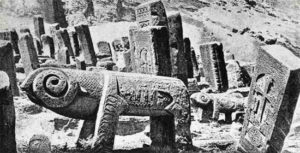
Armenian Cemetery in Djulfa, 1830, Francis Rawdon Chesney, The Expedition for the Survey of the Rivers Euphrates and Tigris, 1850 [543], Wikimedia Commons.
CHW describes the actions of the Azerbaijan government in Nakhichevan as a cultural erasure. The Azerbaijani government now cynically claims that there is no evidence that Armenians ever lived in the region, since all evidence in the form of monuments has been removed.
The researchers at CHW explain that despite the empathy and concern they feel for the people, both Azeri and Armenian, living in these regions in conflict, their research must be limited to monitoring the condition of cultural properties from Soviet or post-Soviet state inventories. They are not able to research either the

Screenshot of Azeri soldiers breaking khachkars with sledgehammers from “The New Tears of Araxes” Written by Sarah Pickman, Produced by Simon Maghakyan. © Simon Maghakyan, 2006.
movement of peoples and elimination of villages, or the damage to sites through a now common Azerbaijan government practice – removing Armenian inscriptions and decorative elements and desecrating or repurposing the buildings. The more subtle destructive acts simply cannot be seen through remote, satellite access. The Azerbaijan government does not allow access to foreign researchers and has even denied the U.S. ambassador permission to visit these sites.
Azerbaijani revisionist history and the “Caucasian Albanian Myth”
“Scholars should be on guard when using Soviet and post-Soviet Azeri editions of Azeri, Persian, and even Russian and Western European sources printed in Baku. These have been edited to remove references to Armenians and have been distributed in large numbers in recent years. When utilizing such sources, the researchers should seek out pre-Soviet editions wherever possible.”
Robert Hewsen, in Armenia: A Historical Atlas, Chicago: Univ of Chicago Press, 2001, p. 291
How does the Azerbaijan government account for the remaining evidence of ancient Armenian culture stretching back a thousand years? Through the creation of an invented history of ‘Caucasian Albanians.’
‘Albanization’ is the term for a 60-year-old popular distortion of the region’s history that has been promoted by the Azerbaijan government as part of its historical agenda. The claims that Armenians have no ancient history in the region is a means of both bolstering the nationalist propaganda that the region is an ‘ancient Azerbaijani land’ and denying modern Armenians the rights to their ancient cultural monuments.
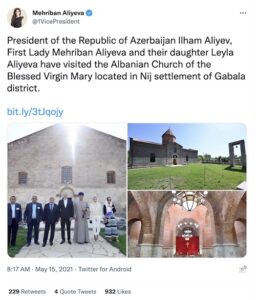
Mehriban Alieva tweet celebrating visit to an Udi Albanian church.
While there is ancient textual evidence of an ancient people known as ‘Albanian’ in the region – who shared territory and some cultural traits with Armenians – they appear to have become absorbed into neighboring cultures long ago. However, the government of Azerbaijan has spun bits and pieces of this history into a completely fabricated pseudo-history in which Albanians, not Armenians inhabited the region for the last 1000 years. This pseudo-history has replaced the facts in textbooks for children and ‘scholarly’ articles alike.
Texts by foreign scholars have been mis-translated with references to Armenian culture removed or distorted and republished in Azerbaijan to support this invented history. The Azeri writers who have helped to perpetrate this fraudulent history, say that objects of Armenian heritage such as the beautiful carved stone stele, also known as cross-stones or khachkars, are actually ‘Albanian’ and represent Mithraic holdovers. They, and the Azerbaijan government accuse Armenians of having desecrated ‘Albanian’ churches and stonework, by carving Armenian texts into the stonework to create false claims to the land.
The Aliyev regime staunchly supports this falsification of history. As part of its campaign to eliminate Armenians’ religious status, the state has provided significant funding and public recognition to a very small Christian group, the Albanian-Udis that the Azerbaijan government says are remnants of the ancient Caucasian Albanians and accuses Armenians and Georgians of suppressing.
What is UNESCO’s response to Azerbaijan’s deliberate erasure of Armenian heritage within its borders?

UNESCO’s Irina Bokova presents the Mozart Medal to Azerbaijan Vice President Aliyeva.
UNESCO has long turned a blind eye to Azerbaijan’s destruction of Armenian heritage. On the contrary, UNESCO furthered Azerbaijan’s cover-up by showering honors on Azerbaijan’s leaders responsible for these atrocities. In June and July 2019, UNESCO’s World Heritage Committee met in Baku, the capital of oil-rich Azerbaijan. Newly elected World Heritage Committee Chairman, Abulfaz Garayev, who was also Azerbaijan’s Minister of Culture, chaired the organization’s 43rd session.
UNESCO had been aware of the Azeri government’s first massive destruction of ancient Armenian khachkars in the cemetery at Djulfa in Nakhchivan in 1998. UNESCO failed to respond at all until 2002, delivering then only a weak protest and failing entirely to protest the complete obliteration of thousands more in 2005, when the ancient cemetery was bulldozed and made into a firing range for soldiers.
(See UNESCO Exposed! World Heritage Committee Meeting in Baku will be Hosted by Cultural Destroyers, Cultural Property News, March 19, 2019.)
In 2010, UNESCO Director-General Irina Bokova presented the Mozart Medal, a top UNESCO award, to First Lady and Vice President of Azerbaijan Mehriban Aliyeva as Goodwill Ambassador of UNESCO and ISESCO, who receives positive press coverage through UNESCO for supporting ‘tolerance and interfaith harmony.’
In 2013, Azerbaijan presented UNESCO with $5 million dollars, helping to offset a serious budget shortfall after the U.S. stopped making payments to the organization in 2011. Soon after, Bokova is said to have facilitated Azerbaijani participation in the UNESCO Leaders Forum, in which President Ilham Aliyev lectured the group on tolerance. President Aliyev said, “multiculturalism is not just an idea, it is our tradition, a state policy and our lifestyle.”
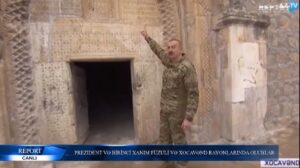
President of Azerbaijan, Ilham Aliev, during his visit to Nagorno-Karabakh in March 2021. He is pointing at the Armenian inscription on the tympanum of a 12-17th century church in Tsakuri/Hunerli village and calling it fake. He also calls the church “our ancient historical monument“ and promises to restore the “ancient Albanian temple.” This means erasing the Armenian inscriptions, which has been already done during a number of church “restorations” in Azerbaijan. The oldest inscription from this church is on a khachkar mentioning the year 1198 (ՈԽԷ in Armenian numerals). The inscription on the tympanum says “…I [Vardapet (abbot) Hakob] reconstructed the former church… in 1682.”
The Guardian also revealed that a Bulgarian consultant, Kalin Mitrev, received “at least €425,000 for private consulting work from a local Azeri company, Avuar Co.” Mitrev said the payments were for legitimate business consultancy. The Guardian noted that the fact that Irina Bokova’s husband had received an enormous payment from an Azeri company might be awkward as Bokova had just opened an exhibition entitled Azerbaijan – A Land of Tolerance at UNESCO’s headquarters in Paris.
UNESCO continues to be criticized for its failure to remove Mehriban Aliyeva as its goodwill ambassador. She remains in UNESCO’s good graces despite her role as first lady in denying the destruction of Armenian khatchkars at Djulfa, and in the removal of Armenian inscriptions at the Church of Saint Elisæus in Nij to transform it into a “Caucasian Albanian” church to say nothing of her support for Azerbaijan’s surprise drone attack on Armenian soldiers and civilians on September 27, 2020.
Her husband, President Aliev, who can be seen here pointing to an early Armenian inscription and declaring it “a fake”, and who declared his commitment to “renovate” a 12th C. Armenian church into an Albanian Church, remains a true friend in UNESCO’s eyes. Despite Azerbaijan’s well-documented history of destruction of Armenian heritage, it was elected a member of the UNESCO Committee for the Protection of Cultural Property in the Event of an Armed Conflict in December 2021.
Why doesn’t the world hear more about Azerbaijan’s deliberate destruction of Armenian heritage?
One reason is its continuing campaign to buy friends in the international cultural sector and the media – another reason may be its global reputation as one of the worst countries in the world to be a journalist.
The following quote from an interview with researcher Argam Ayvazyan shows both the origin of Azerbaijan’s campaign of deception, and how long it has been going on:
“It was in 1965. I bought a very cheap camera and went from my native village of Arinj to the nearby village of Nors… I was openly photographing the church, the inscriptions, and the khachkars. The [Azerbaijani] villagers gathered and started asking who I was, what I was doing there and so on. I told them I was from a nearby village and was taking pictures just for my own interest. Coincidentally, there were two policemen in the village that day. They were immediately informed and I was arrested and taken to the regional police station.
We were waiting in the corridor and some time later, the chief officer went out of his office with a tall man in civilian clothes. The latter immediately asked the policemen, “What did this boy do? Did he steal something?” They said, “No, comrade Aliyev, we brought him from the Nors village, he was taking pictures of the church.” “Then bring him in.” I was taken inside, we sat down, they brought tea… He started asking questions about why I was taking the pictures (we spoke in Azerbaijani). The man took the camera, removed the film, threw it aside and said:
“This was the first time. Go and don’t do such a thing again. Forget there are any Armenian monuments or Armenians in Nakhichevan.”
That was Heydar Aliyev, the head of the KGB in Nakhichevan, of whom, of course, I didn’t know at the time.”
Heydar Aliev became first secretary of the Azerbaijani Soviet Republic, then the first president of independent Azerbaijan. He is the father of today’s president of Azerbaijan, Ilham Aliyev.
Other reading and viewing:
Simon Manghakyan, Cultural Desecration is Racial Discrimination, Foreign Policy, January 13, 2022.
The New Tears of Araxes, Film written by Sarah Pickman. Narrated and Produced by Simon Maghakyan. © Simon Maghakyan, 2006. Djulfa Virtual Memorial and Museum.
Targeting Culture (resources and links re destruction of Armenian heritage) The Institute for the Study of Human Rights, Columbia University.
Argam Ayvazyan: Spy–Researcher For Nakhichevan Armenian Culture, an interview by Andran Abramian, Cultural Property News, March 27, 2021
UNESCO Exposed! World Heritage Committee Meeting in Baku will be Hosted by Cultural Destroyers, Cultural Property News, March 19, 2019
Beyond nationalism, there is also… money. Additional reading on the overseas financial holdings of the Aliyev family may be found here:
Svetlana Tiourina, The Azerbaijani Laundromat, OCCRP, September 14, 2017.
Miranda Patrucic, Ilya Lozovsky, Kelly Bloss, and Tom Stocks, The Pandora Papers. The Aliev Family’s London Property Empire, Azerbaijan’s Ruling Aliyev Family And Their Associates Acquired Dozens Of Prime London Properties Worth Nearly $700 Million, credit James O’Brien/OCCRP, 3 October 2021
[i] Luke Harding, UK at centre of secret $3bn Azerbaijani money laundering and lobbying scheme, The Guardian, 4 September 2017. According to Harding, “…the Azerbaijani leadership, accused of serial human rights abuses, systemic corruption and rigging elections, made more than 16,000 covert payments from 2012 to 2014. Some of this money went to politicians and journalists, as part of an international lobbying operation to deflect criticism of Azerbaijan’s president, Ilham Aliyev, and to promote a positive image of his oil-rich country. There is no suggestion that all the recipients were aware of the original source of the money. It arrived via a disguised route.”
Note: This article has been updated to correct a reference to “cultural genocide” to the expression “cultural erasure.”
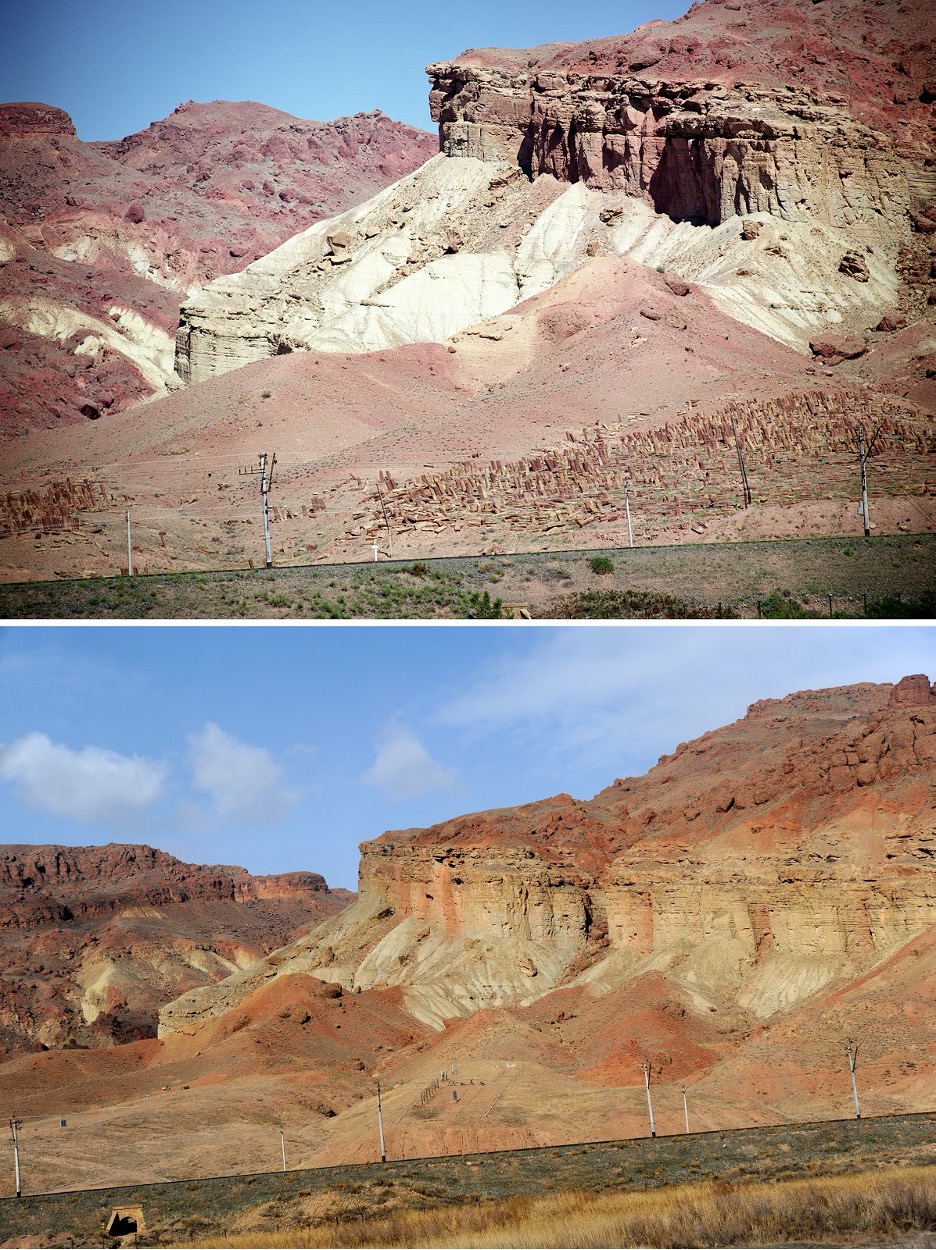 Djulfa cemetery with thousands of khachkars before its destruction in the 1990s and its cleared site turned into a shooting range in 2006. photos taken from the Iranian side of the border. Courtesy Argam Ayvazyan.
Djulfa cemetery with thousands of khachkars before its destruction in the 1990s and its cleared site turned into a shooting range in 2006. photos taken from the Iranian side of the border. Courtesy Argam Ayvazyan. 


